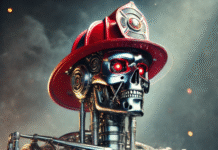The Future of Humanoid Robots: Pioneers and Opportunities in the Market
A Glimpse into the Humanoid Robot Revolution
Humanoid robots, once confined to the realms of science fiction, are now stepping into reality. With advancements in artificial intelligence (AI) and robotics, significant players like Nvidia, Tesla, Hyundai’s Boston Dynamics, and Foxconn are capturing the spotlight in this burgeoning market. These companies are positioning themselves to revolutionize how humans interact with machines, paving the way for practical humanoid robots that could transform various industries.
Nvidia’s Ambitious Vision for Humanoids
In January 2025, at the Consumer Electronics Show (CES), Nvidia CEO Jensen Huang projected a future where humanoid robots would astonish everyone with their capabilities within the next decade. Nvidia is at the forefront of this technological push, with their extensive range of products tailored for humanoid robot development. The rise of generative AI, particularly marked by the launch of ChatGPT in late 2022, has enabled Nvidia to broaden its offerings in this domain.
Nvidia boasts a comprehensive toolkit—including software and hardware—designed to facilitate the development of humanoid robots. This lets companies progress from concept and training to deployment effectively.
Investment Insights: A Practical Approach
Investing in Nvidia is currently deemed the most viable option for gaining exposure to the humanoid robot sector. Their platform is utilized by a plethora of companies venturing into humanoid development, such as Boston Dynamics, Agility Robotics, and Xpeng Robotics. While these other companies are diverting substantial resources to develop their robots, Nvidia is reaping financial benefits from its technology, anticipating even greater returns as humanoid production scales up.
Tesla’s Optimus: Leading the Charge in Humanoid Robotics
Undoubtedly, one of the most recognized humanoid projects is Tesla’s Optimus. Since its introduction during Tesla’s AI Day in 2021, Elon Musk has showcased multiple prototypes, capturing public imagination and sparking widespread media interest.
A Timeline for Innovation
During Tesla’s recent earnings call, Musk outlined crucial milestones for the Optimus project:
- Prototype Version 3 is set for unveiling in early 2026.
- A production line capable of manufacturing 1 million Optimus robots is slated to commence by late next year.
- However, achieving an annual production rate of 1 million units will take time due to its complexity and the absence of an established supply chain.
Elon Musk’s ambitious timelines often inspire skepticism, as he has a history of underestimating the time required to deliver on new products.
Hyundai’s Strategic Acquisition of Boston Dynamics
In a notable move, Hyundai Motor Group acquired an 80% stake in Boston Dynamics, solidifying its position in the robotics realm. Boston Dynamics, established as a spin-off from the Massachusetts Institute of Technology (MIT) in 1992, is known for its pioneering robots akin to the human form.
The Path Forward with Atlas
Boston Dynamics has garnered accolades for its Atlas humanoid robot, which has shown remarkable agility and capabilities. With the commercialization of Atlas expected soon, Hyundai is banking on Boston Dynamics to become a key growth driver, albeit investors in the U.S. face challenges acquiring its shares directly from the Korea Exchange (KRX).
Foxconn’s Automation Approach in the Humanoid Sphere
Another industry titan, Foxconn, is recognized globally as the leading contract electronics manufacturer, particularly as a major supplier for Apple products. This Taiwan-based company has recently begun leveraging humanoid robotics to enhance its operations.
The Nvidia and Foxconn Collaboration
Since October 2023, Foxconn has collaborated with Nvidia, planning to integrate Nvidia’s tech into its operations. The partnership aims to harness AI to bolster productivity and efficiency in their manufacturing processes, including the introduction of humanoid robots at its Houston plant.
Foxconn’s commitment to deploying these robots signals a shift in how manufacturing facilities can optimize operations with AI technology.
Market Forecasts: A Bright Outlook for Humanoid Robotics
Goldman Sachs endorses the growth of the humanoid robot market, projecting 1.4 million shipments by 2035, with a bullish scenario suggesting nearly 1 million shipments by 2031. This optimistic forecast underlines the burgeoning demand for humanoid robots across various sectors.
Navigating Investment Opportunities
It’s crucial to highlight that none of the leading players in the humanoid robot market are pure plays in this domain. Therefore, potential investors should closely monitor the core business performance of these companies while considering their involvement in humanoid robotics.
Apple: The Mystery of a Humanoid Robot
Amidst the excitement surrounding established players, speculation is rife that Apple is also dipping its toes into the humanoid market. While details remain scarce, it’s rumored that Apple’s first ventures will focus on a tabletop robotic arm before launching a full-fledged humanoid robot.
Conclusion: Preparing for the Humanoid Future
As it stands, the humanoid robot market is on the verge of a significant breakthrough. With industry leaders like Nvidia, Tesla, Hyundai’s Boston Dynamics, and Foxconn spearheading innovations, the possibilities appear limitless. Though navigating investment opportunities poses its challenges, the potential rewards could redefine productivity, efficiency, and human-robot collaboration across numerous sectors. As we look ahead, the transformation of the humanoid robot landscape seems inevitable, reflecting our ever-evolving technological narrative. The future is indeed exciting, and the possibilities for investment and development in this field are vast.







